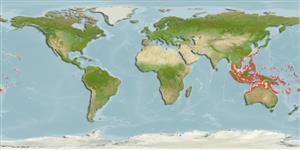>
Ovalentaria/misc (Various families in series Ovalentaria) >
Pomacentridae (Damselfishes) > Pomacentrinae
Etymology: Amphiprion: Greek, amphi = on both sides + Greek, prion, -onos = saw (Ref. 45335).
More on author: Bleeker.
Environment: milieu / climate zone / depth range / distribution range
นิเวศวิทยา
เกี่ยวกับทะเล,น้ำเค็ม; กร่อย เกี่ยวกับหินโสโครก; ไม่มีการอพยพย้ายถิ่น; ระดับความลึก 1 - 38 m (Ref. 86942). Tropical; 34°N - 22°S, 96°E - 156°E (Ref. 55269)
Western Pacific: Gulf of Thailand and Cocos-Keeling in the eastern Indian Ocean to Samoa and Tonga (Ref. 53797), north to the Ryukyu Islands, south to the Great Barrier Reef, and New Caledonia.
Length at first maturity / ขนาด / น้ำหนัก / Age
Maturity: Lm ?, range 6 - ? cm
Max length : 10.0 cm TL เพศผู้/กระเทย; (Ref. 9710)
Short description
เครื่องมือที่ใช้ในการแยกชนิดสัตว์,สิ่งมีชีวิตออกจากกัน | สัณฐานวิทยา | ความยาวต่างๆ
เงี่ยงครีบหลัง (รวม) : 9 - 10; ก้านครีบอ่อนที่หาง (รวม) : 16 - 17; เงี่ยงครีบก้น: 2; ก้านครีบอ่อนที่ก้น: 12 - 13.
Adults inhabit lagoon and seaward reefs (Ref. 1602). Mainly diurnal. Non-burrowing. Monogamous (Ref. 52884). A protandrous hermaphrodite (Ref. 32166). Oviparous, distinct pairing during breeding (Ref. 205). Eggs are demersal and adhere to the substrate (Ref. 205). Males guard and aerate the eggs (Ref. 205). Associated with the anemones: Heteractis magnifica (usually), Heteractis crispa, Macrodactyla doreensis, Stichodactyla gigantea (Ref. 5911). In Bali they occur together with the closely related Indian Ocean species A. akallopison and have even been found sharing the same anemone (Ref. 48636). Has been reared in captivity (Ref. 35413, 35418, 35420).
Oviparous, distinct pairing during breeding (Ref. 205). Monogamous mating is observed as both obligate and social (Ref. 52884). Eggs are demersal and adhere to the substrate (Ref. 205). Males guard and aerate the eggs (Ref. 205). One pair spawns several times per year. Annual fecundity is estimated to be 2,000 to 4,000 eggs. Size at sex change = 5.4 cm TL (Ref. 55367). Also Ref. 240, 7471.
Allen, G.R., 1991. Damselfishes of the world. Mergus Publishers, Melle, Germany. 271 p. (Ref. 7247)
IUCN Red List Status (Ref. 130435: Version 2024-2)
Threat to humans
Harmless
Human uses
การประมง: ไม่มีผลประโยชน์; สถานที่แสดงสัตว์และพืชน้ำ: การค้า
เครื่องมือ
Special reports
Download XML
แหล่งที่มาจากอินเตอร์เน็ต
Estimates based on models
Preferred temperature (Ref.
123201): 25.2 - 29, mean 28 °C (based on 668 cells).
Phylogenetic diversity index (Ref.
82804): PD
50 = 0.5000 [Uniqueness, from 0.5 = low to 2.0 = high].
Bayesian length-weight: a=0.02344 (0.01134 - 0.04848), b=2.98 (2.80 - 3.16), in cm total length, based on LWR estimates for this (Sub)family-body shape (Ref.
93245).
ระดับชั้นอาหาร (Ref.
69278): 2.2 ±0.0 se; based on diet studies.
Generation time: 2.3 ( na - na) years. Estimated as median ln(3)/K based on 1
growth studies.
ความสามารถในการกลับคืนสู่ปกติ (Ref.
120179): ขนาดกลาง, เวลาต่ำสุดที่จะทำให้ประชากรเพิ่มขึ้นเป็น 2 เท่าใช้เวลา 1.4 - 4.4 ปี (K=0.48; tm=1.75-1.83; annual Fec=2,000-4,000).
Fishing Vulnerability (Ref.
59153): Low to moderate vulnerability (26 of 100).
Nutrients (Ref.
124155): Calcium = 111 [49, 178] mg/100g; Iron = 0.729 [0.430, 1.319] mg/100g; Protein = 18.1 [16.9, 19.3] %; Omega3 = 0.121 [0.068, 0.207] g/100g; Selenium = 23.3 [11.3, 48.4] μg/100g; VitaminA = 94.4 [22.7, 361.4] μg/100g; Zinc = 2.33 [1.52, 3.68] mg/100g (wet weight);
